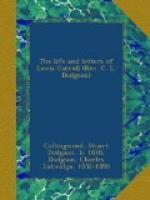I have made no attempt to chronicle all the games and puzzles which Lewis Carroll invented. A list of such as have been published will be found in the Bibliographical chapter. He intended to bring out a book of “Original Games and Puzzles,” with illustrations by Miss E. Gertrude Thomson. The MS. was, I believe, almost complete before his death, and one, at least, of the pictures had been drawn. On June 30th he wrote in his Diary, “Invented what I think is a new kind of riddle. A Russian had three sons. The first, named Rab, became a lawyer; the second, Ymra, became a soldier; the third became a sailor. What was his name?”
The following letter written to a child-friend, Miss E. Drury, illustrates Lewis Carroll’s hatred of bazaars:—
Ch. Ch., Oxford, Nov. 10, 1892.
My dear Emmie,—I object to all bazaars on the general principle that they are very undesirable schools for young ladies, in which they learn to be “too fast” and forward, and are more exposed to undesirable acquaintances than in ordinary society. And I have, besides that, special objections to bazaars connected with charitable or religious purposes. It seems to me that they desecrate the religious object by their undesirable features, and that they take the reality out of all charity by getting people to think that they are doing a good action, when their true motive is amusement for themselves. Ruskin has put all this far better than I can possibly do, and, if I can find the passage, and find the time to copy it, I will send it you. But time is a very scarce luxury for me!
Always yours affectionately,
C.L. Dodgson.
In his later years he used often to give lectures on various subjects to children. He gave a series on “Logic” at the Oxford Girls’ High School, but he sometimes went further afield, as in the following instance:—
Went, as arranged with Miss A. Ottley, to the High School at Worcester, on a visit. At half-past three I had an audience of about a hundred little girls, aged, I should think, from about six to fourteen. I showed them two arithmetic puzzles on the black-board, and told them “Bruno’s Picnic.” At half-past seven I addressed some serious words to a second audience of about a hundred elder girls, probably from fifteen to twenty—an experience of the deepest interest to me.
The illustration on the next page will be best explained by the following letter which I have received from Mr. Walter Lindsay, of Philadelphia, U.S.:—
Phila., September 12, 1898.
Dear Sir,—I shall be very glad to furnish what information I can with respect to the “Mechanical Humpty Dumpty” which I constructed a few years ago, but I must begin by acknowledging that, in one sense at least, I did not “invent” the figure. The idea was first put into my head by an article in the Cosmopolitan, somewhere about 1891, I




